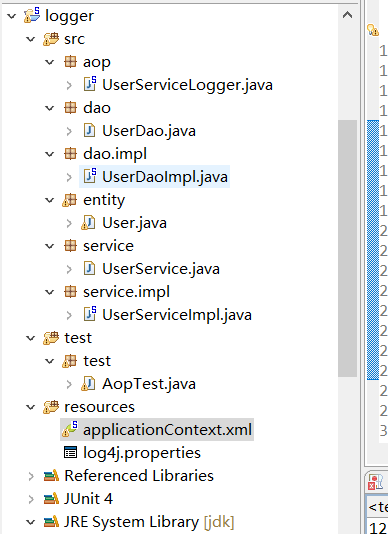小编给大家分享一下Spring框架如何实现AOP添加日志记录功能,相信大部分人都还不怎么了解,因此分享这篇文章给大家参考一下,希望大家阅读完这篇文章后大有收获,下面让我们一起去了解一下吧!
需求,在调用业务方法的时候,在被调用的业务方法的前面和后面添加上日志记录功能
整体架构:

日志处理类:
package aop;
import java.util.Arrays;
import org.apache.log4j.Logger;
import org.aspectj.lang.JoinPoint;
//日志处理类 增强处理类-日志
public class UserServiceLogger {
private Logger logger = Logger.getLogger(UserServiceLogger.class);
// 前置增强
public void before(JoinPoint joinPoint) {
logger.info("调用" + joinPoint.getTarget() + "的"
+ joinPoint.getSignature() + "方法,方法参数是:"
+ Arrays.toString(joinPoint.getArgs()));
}
// 后置增强
public void afterReturning(JoinPoint joinPoint,Object result) {
logger.info("调用" + joinPoint.getTarget() + "的"
+ joinPoint.getSignature() + "方法,方法的返回值是:"
+result);
}
}下面是一个三层架构模式:
package dao;
import entity.User;
/**
* 增加DAO接口,定义了所需的持久化方法
*/
public interface UserDao {
public void save(User user);
}package dao.impl;
import dao.UserDao;
import entity.User;
/**
* 用户DAO类,实现IDao接口,负责User类的持久化操作
*/
public class UserDaoImpl implements UserDao {
public void save(User user) {
// 这里并未实现完整的数据库操作,仅为说明问题
System.out.println("保存用户信息到数据库");
}
}package entity;
/**
* 用户实体类
*/
public class User implements java.io.Serializable {
private Integer id; // 用户ID
private String username; // 用户名
private String password; // 密码
private String email; // 电子邮件
// getter & setter
public Integer getId() {
return id;
}
public void setId(Integer id) {
this.id = id;
}
public String getUsername() {
return username;
}
public void setUsername(String username) {
this.username = username;
}
public String getPassword() {
return password;
}
public void setPassword(String password) {
this.password = password;
}
public String getEmail() {
return email;
}
public void setEmail(String email) {
this.email = email;
}
}package service;
import entity.User;
/**
* 用户业务接口,定义了所需的业务方法
*/
public interface UserService {
public void addNewUser(User user);
}package service.impl;
import service.UserService;
import dao.UserDao;
import entity.User;
/**
* 用户业务类,实现对User功能的业务管理
*/
public class UserServiceImpl implements UserService {
// 声明接口类型的引用,和具体实现类解耦合
private UserDao dao;
// dao 属性的setter访问器,会被Spring调用,实现设值注入
public void setDao(UserDao dao) {
this.dao = dao;
}
public void addNewUser(User user) {
// 调用用户DAO的方法保存用户信息
dao.save(user);
}
}编写单元测试方法:
package test;
import org.junit.Test;
import org.springframework.context.ApplicationContext;
import org.springframework.context.support.ClassPathXmlApplicationContext;
import service.UserService;
import service.impl.UserServiceImpl;
import entity.User;
public class AopTest {
@Test
public void aopTest() {
ApplicationContext ctx = new ClassPathXmlApplicationContext("applicationContext.xml");
UserService service = (UserService) ctx.getBean("service");
User user = new User();
user.setId(1);
user.setUsername("test");
user.setPassword("123456");
user.setEmail("test@xxx.com");
service.addNewUser(user);
}
}applicationContext.xml核心配置文件:
<?xml version="1.0" encoding="UTF-8"?>
<beans xmlns="http://www.springframework.org/schema/beans"
xmlns:xsi="http://www.w3.org/2001/XMLSchema-instance"
xmlns:aop="http://www.springframework.org/schema/aop"
xsi:schemaLocation="http://www.springframework.org/schema/beans
http://www.springframework.org/schema/beans/spring-beans-3.2.xsd
http://www.springframework.org/schema/aop
http://www.springframework.org/schema/aop/spring-aop-3.2.xsd">
<bean id="dao" class="dao.impl.UserDaoImpl"></bean>
<bean id="service" class="service.impl.UserServiceImpl">
<property name="dao" ref="dao"></property>
</bean>
<!-- 声明增强方法所在的Bean -->
<bean id="theLogger" class="aop.UserServiceLogger"></bean>
<!-- 配置切面 -->
<aop:config>
<!-- 定义切入点 -->
<aop:pointcut id="pointcut"
expression="execution(public void addNewUser(entity.User))" />
<!-- 引用包含增强方法的Bean -->
<aop:aspect ref="theLogger">
<!-- 将before()方法定义为前置增强并引用pointcut切入点 -->
<aop:before method="before" pointcut-ref="pointcut"></aop:before>
<!-- 将afterReturning()方法定义为后置增强并引用pointcut切入点 -->
<!-- 通过returning属性指定为名为result的参数注入返回值 -->
<aop:after-returning method="afterReturning"
pointcut-ref="pointcut" returning="result" />
</aop:aspect>
</aop:config>
</beans>运行结果:
12-29 15:13:06[INFO]org.springframework.context.support.ClassPathXmlApplicationContext
-Refreshing org.springframework.context.support.ClassPathXmlApplicationContext@2db0f6b2: startup date [Sun Dec 29 15:13:06 CST 2019]; root of context hierarchy
12-29 15:13:06[INFO]org.springframework.beans.factory.xml.XmlBeanDefinitionReader
-Loading XML bean definitions from class path resource [applicationContext.xml]
12-29 15:13:06[INFO]org.springframework.beans.factory.support.DefaultListableBeanFactory
-Pre-instantiating singletons in org.springframework.beans.factory.support.DefaultListableBeanFactory@3701eaf6: defining beans [userDao,service,theLogger,org.springframework.aop.config.internalAutoProxyCreator,pointcut,org.springframework.aop.aspectj.AspectJPointcutAdvisor#0,org.springframework.aop.aspectj.AspectJPointcutAdvisor#1]; root of factory hierarchy
12-29 15:13:06[INFO]aop.UserServiceLogger
-调用service.impl.UserServiceImpl@3c130745的void service.UserService.addNewUser(User)方法,方法参数是:[entity.User@2e4b8173]
保存用户信息到数据库
12-29 15:13:06[INFO]aop.UserServiceLogger
-调用service.impl.UserServiceImpl@3c130745的void service.UserService.addNewUser(User)方法,方法的返回值是:null以上是“Spring框架如何实现AOP添加日志记录功能”这篇文章的所有内容,感谢各位的阅读!相信大家都有了一定的了解,希望分享的内容对大家有所帮助,如果还想学习更多知识,欢迎关注亿速云行业资讯频道!
亿速云「云服务器」,即开即用、新一代英特尔至强铂金CPU、三副本存储NVMe SSD云盘,价格低至29元/月。点击查看>>
免责声明:本站发布的内容(图片、视频和文字)以原创、转载和分享为主,文章观点不代表本网站立场,如果涉及侵权请联系站长邮箱:is@yisu.com进行举报,并提供相关证据,一经查实,将立刻删除涉嫌侵权内容。